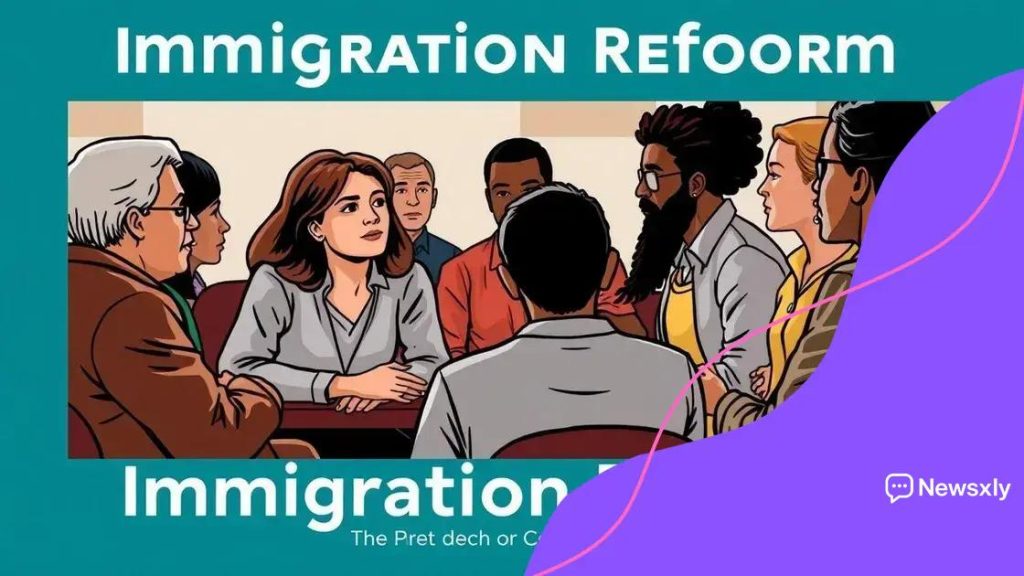Discussions on immigration reform: what you need to know

Discussions on immigration reform encompass the challenges and opportunities within the system, focusing on key elements like public opinion, legislative processes, and the impacts on immigrant communities and society at large.
Discussions on immigration reform are more relevant than ever. With ongoing debates in Congress and communities, it’s essential to grasp how these changes could affect individuals and families across the nation. Have you ever wondered what a reformed immigration system might look like?
Understanding immigration reform: key concepts
Understanding immigration reform is crucial in today’s ever-changing political landscape. The various key concepts surrounding this topic help shed light on how policies are shaped and implemented.
First, it’s important to recognize what immigration reform actually means. It typically involves changes to laws and policies that govern how individuals live and work in a country. These reforms aim to address challenges in the existing system and make it more effective.
The main goals of immigration reform
The objectives of immigration reform often revolve around improving the system for both immigrants and citizens. Here are some key goals:
- Enhancing security: Ensuring that borders are secure while allowing for a smooth flow of people.
- Providing pathways to citizenship: Creating options for undocumented immigrants to earn legal status.
- Supporting economic growth: Addressing labor shortages by allowing skilled workers to enter the job market.
Furthermore, understanding the terms associated with immigration reform is vital. Terms such as visa optimization, asylum seeker, and deportation often arise in discussions. These terms reflect the challenges faced by individuals seeking a better life and the complexities of the legal framework.
Key challenges in reforming immigration laws
Reforming immigration laws is not without its hurdles. Complex political dynamics often come into play, leading to heated debates. The different perspectives can create disagreements even among lawmakers.
Additionally, the impact of reforms can vary significantly across different communities. Some people may benefit, while others could experience negative consequences.
It is crucial for citizens to engage in these discussions. By understanding immigration reform, individuals can make informed decisions, voice their opinions, and advocate for changes that reflect their values. Staying informed about current policies and community impacts is an essential step towards active participation in the democratic process.
As we delve deeper into various aspects of immigration reform, we’ll uncover how these key concepts influence everyday lives and the future direction of immigration policies.
Current state of immigration policies
The current state of immigration policies significantly affects millions of people. Understanding these policies is essential for grasping how **immigration reform** is being shaped today.
Recently, immigration policies have seen notable changes. For instance, some administrations have made efforts to tighten border security while others have proposed pathways for undocumented immigrants. These contrasting approaches create a complex environment where laws can vary widely.
Key elements of current immigration policies
Several critical aspects define today’s immigration policies:
- Border enforcement: Increasing resources and technology to improve security at borders.
- Work permits: Programs that allow immigrants to work legally under certain conditions.
- Family reunification: Policies aimed at keeping families together through immigration processes.
Amidst these elements, it’s vital to consider how these policies impact various groups. For example, refugees often face lengthy waiting periods, while skilled workers may benefit from expedited processes. The differences highlight the challenges immigrants face when navigating these policies.
The role of public opinion
Public opinion also plays a critical role in shaping immigration policies. Depending on societal attitudes, reforms can either gain traction or face significant opposition. Engaging in community discussions helps raise awareness about the nuances of immigration policy.
Furthermore, advocacy groups actively lobby for change, addressing the needs of immigrants and pushing for reforms that reflect a more compassionate approach. This advocacy often emphasizes the hardships faced by individuals and families in vulnerable situations, which can resonate with the public.
As the political climate evolves, monitoring the current state of immigration policies becomes essential. Changes can happen swiftly, and staying informed ensures that individuals are aware of their rights and the opportunities available to them.
Impact of immigration reform on society

The impact of immigration reform on society is profound and multifaceted. Changes to immigration laws can shape communities, economies, and cultural dynamics in significant ways.
When policies shift, both positive and negative effects can emerge. For example, immigration reform that facilitates a pathway to citizenship can lead to increased community engagement. People feel empowered to contribute and participate in civic life, enriching the social fabric.
Positive impacts of immigration reform
Some of the benefits we see include:
- Economic growth: Immigrants often fill vital roles in the workforce, stimulating economic activity and innovation.
- Cultural diversity: A more diverse society can bring new perspectives and ideas, enhancing creativity and innovation.
- Community development: Immigrants contribute to local economies, often opening new businesses and creating jobs.
Moreover, the inclusion of immigrants helps address labor shortages in various sectors, such as healthcare and agriculture. For instance, many farms rely on immigrant labor to sustain their operations, highlighting the essential role that these workers play.
Challenges and considerations
Despite these benefits, challenges also arise. Some citizens may fear that immigration reform could lead to job competition. Additionally, misconceptions about immigrants can create social tensions. It’s vital to address these concerns through education and community dialogue.
Integrating immigrants into society requires thoughtful policies that consider everyone’s needs. When implemented effectively, immigration reform can promote a sense of belonging for all individuals, regardless of their origin.
As we navigate the complexities of immigration reform, understanding its implications helps create a more cohesive society. Engaging in open conversations about these changes allows us all to contribute to the ongoing dialogue.
Challenges in implementing immigration reform
Challenges in implementing immigration reform can be complex and multifaceted. These obstacles can affect both policymakers and the immigrant community.
One of the main difficulties is the political landscape. Immigration is often a hot-button issue, leading to polarized opinions. As a result, passing comprehensive reforms can take years of negotiation and compromise. Lawmakers may face pressure from various groups, which can complicate the decision-making process.
Common challenges faced
Several key challenges arise during the process of implementing immigration reform:
- Public opinion: Misconceptions and fears about immigration can create resistance to reform.
- Resource allocation: Implementing new policies requires funding and manpower, which are often limited.
- Legislative gridlock: Conflicts among lawmakers can prevent progress on proposed reforms.
Additionally, the bureaucratic systems in place can pose challenges. For many immigrants, navigating the immigration process can be confusing and overwhelming, especially due to language barriers and complicated legal terms. This complexity can result in backlogs and delays, further complicating access to essential services.
The impact on immigrant communities
The fear of deportation continues to loom over undocumented immigrants. This fear can discourage individuals from seeking legal help or reporting crimes, which can create safety concerns in communities. Many immigrants feel trapped and uncertain about their futures, leading to increased anxiety.
Furthermore, as immigration reform discussions evolve, instances of misinformation can arise. Accurate data and transparent communication are vital to ensuring that individuals understand their rights and the changes occurring within the immigration system.
Engaging communities in this dialogue is essential. When individuals understand the challenges surrounding immigration reform, they can become better advocates for their rights and the rights of others. Promoting understanding and empathy within communities can help ease tensions and encourage collaboration.
Future outlook on immigration legislation
The future outlook on immigration legislation is a topic of great importance and uncertainty. With changing political climates and social attitudes, the direction of immigration policies remains unpredictable.
One key aspect of this outlook is the potential for comprehensive reform. Lawmakers continue to discuss various proposals that could reshape the immigration landscape. These discussions often reflect the needs of both immigrants and the broader community.
Trends shaping future legislation
Several trends are likely to influence immigration legislation:
- Public support: Growing advocacy for immigrant rights can push legislators to consider reforms that are more inclusive.
- Evolving workforce needs: As economies recover, the need for skilled workers will remain a priority, shaping visa policies.
- Security concerns: Ongoing discussions about national security will continue to impact the framing of immigration laws.
Moreover, advancements in technology and data collection can facilitate better tracking and management of immigration processes. This can lead to more efficient systems that help both immigrants and governmental agencies. With better technology, the burdensome paperwork and long waiting times may be reduced.
The role of community engagement
Community engagement will play a crucial role in shaping future legislation. As people become more informed, they can advocate for changes that reflect their values. Educational initiatives can foster understanding about the contributions immigrants make to society.
In addition, policymakers need to consider the stories and challenges faced by individuals navigating the immigration system. Meaningful conversations can bridge gaps between communities and lawmakers, leading to more empathetic and effective policies.
As we look to the future, it is clear that the evolution of immigration legislation will require a collaborative effort. Stakeholders from various sectors must come together to craft solutions that honor both the needs of immigrants and the values of society as a whole.
FAQ – Frequently Asked Questions about Immigration Reform
What is the main goal of immigration reform?
The main goal of immigration reform is to create a fairer and more efficient system for immigrants, addressing issues like pathways to citizenship and workforce needs.
How does public opinion affect immigration legislation?
Public opinion plays a crucial role in shaping immigration legislation. Support for immigrant rights can lead to more inclusive policies, while fear and misconceptions can create resistance.
What are some challenges facing immigration reform efforts?
Challenges include political polarization, limited resources, and complex bureaucratic systems that can delay reforms and affect immigrant communities.
How can communities engage in immigration discussions?
Communities can engage by hosting forums, educating themselves on immigration issues, and advocating for changes that reflect their values and support immigrant rights.





